Swinburne University: V-Line Train VR Modules for Safety Project
VerifiedAdded on 2023/03/23
|60
|15232
|97
Project
AI Summary
This project focuses on the development and evaluation of V-line train VR modules for safety and ergonomic enhancements, addressing the increasing need for improved safety measures in rail transport. The study begins with a comprehensive literature review, examining train control systems, accident causes, and the potential of virtual reality (VR) in training for critical events. It explores sociotechnical system approaches, human factors, rail safety, and capacity management. The methodology includes participant selection, VR glasses design, and a detailed design procedure for creating effective VR training modules. The results and discussion delve into subsystem views and project management aspects, including constraints and Gantt charts. The project concludes by highlighting the potential of VR in enhancing safety and ergonomics in V-line train operations, with recommendations for future research. This document is available on Desklib, a platform providing study tools and resources for students.
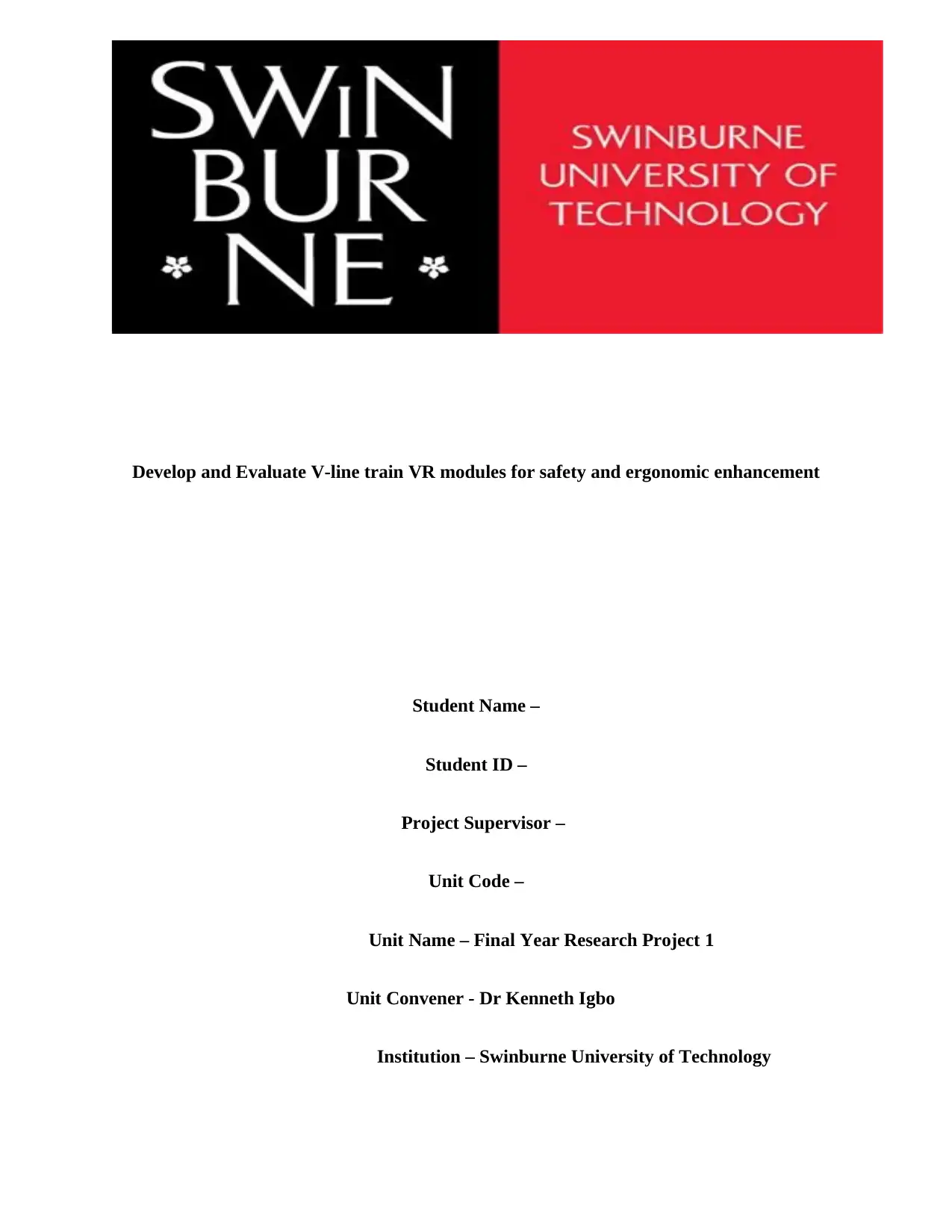
Develop and Evaluate V-line train VR modules for safety and ergonomic enhancement
Student Name –
Student ID –
Project Supervisor –
Unit Code –
Unit Name – Final Year Research Project 1
Unit Convener - Dr Kenneth Igbo
Institution – Swinburne University of Technology
Student Name –
Student ID –
Project Supervisor –
Unit Code –
Unit Name – Final Year Research Project 1
Unit Convener - Dr Kenneth Igbo
Institution – Swinburne University of Technology
Paraphrase This Document
Need a fresh take? Get an instant paraphrase of this document with our AI Paraphraser
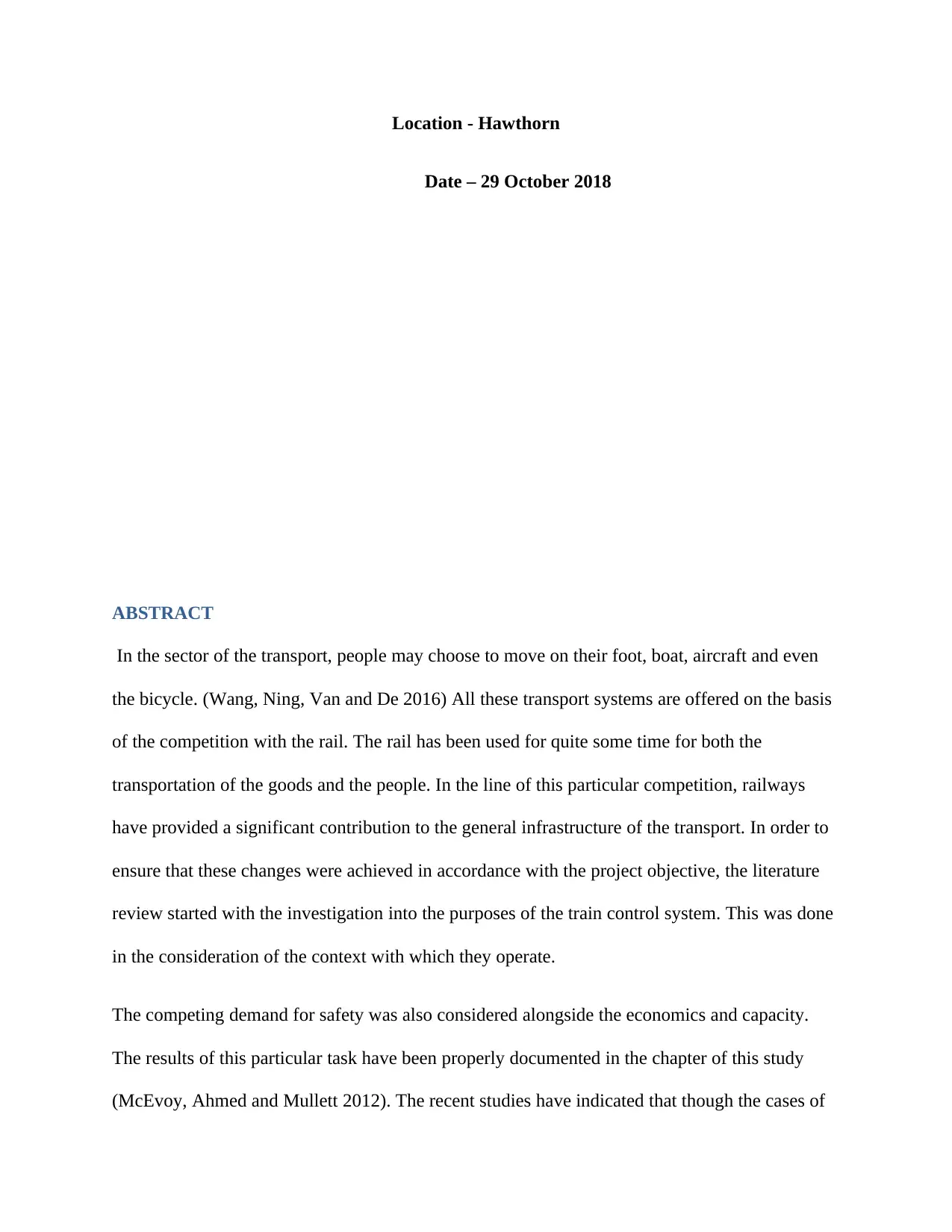
Location - Hawthorn
Date – 29 October 2018
ABSTRACT
In the sector of the transport, people may choose to move on their foot, boat, aircraft and even
the bicycle. (Wang, Ning, Van and De 2016) All these transport systems are offered on the basis
of the competition with the rail. The rail has been used for quite some time for both the
transportation of the goods and the people. In the line of this particular competition, railways
have provided a significant contribution to the general infrastructure of the transport. In order to
ensure that these changes were achieved in accordance with the project objective, the literature
review started with the investigation into the purposes of the train control system. This was done
in the consideration of the context with which they operate.
The competing demand for safety was also considered alongside the economics and capacity.
The results of this particular task have been properly documented in the chapter of this study
(McEvoy, Ahmed and Mullett 2012). The recent studies have indicated that though the cases of
Date – 29 October 2018
ABSTRACT
In the sector of the transport, people may choose to move on their foot, boat, aircraft and even
the bicycle. (Wang, Ning, Van and De 2016) All these transport systems are offered on the basis
of the competition with the rail. The rail has been used for quite some time for both the
transportation of the goods and the people. In the line of this particular competition, railways
have provided a significant contribution to the general infrastructure of the transport. In order to
ensure that these changes were achieved in accordance with the project objective, the literature
review started with the investigation into the purposes of the train control system. This was done
in the consideration of the context with which they operate.
The competing demand for safety was also considered alongside the economics and capacity.
The results of this particular task have been properly documented in the chapter of this study
(McEvoy, Ahmed and Mullett 2012). The recent studies have indicated that though the cases of
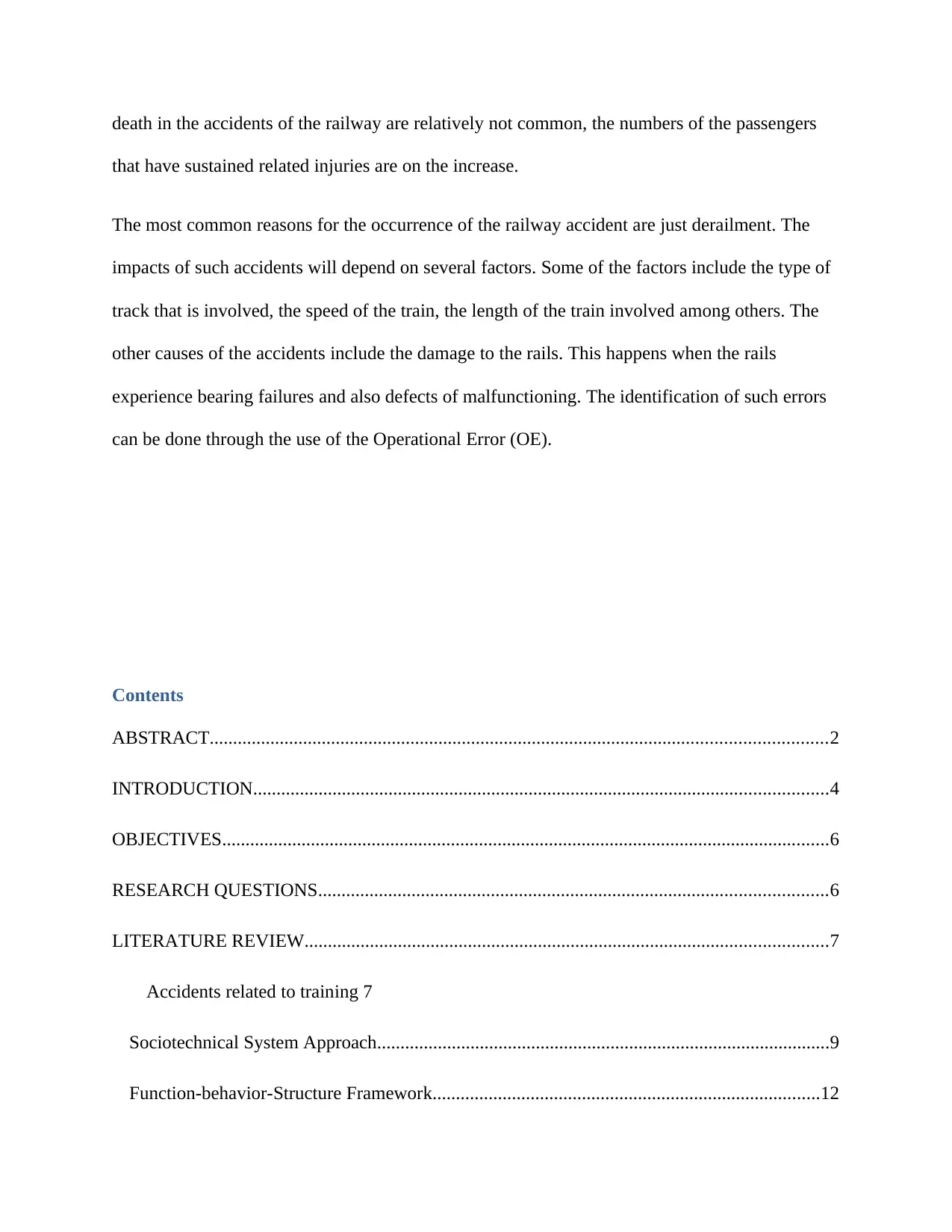
death in the accidents of the railway are relatively not common, the numbers of the passengers
that have sustained related injuries are on the increase.
The most common reasons for the occurrence of the railway accident are just derailment. The
impacts of such accidents will depend on several factors. Some of the factors include the type of
track that is involved, the speed of the train, the length of the train involved among others. The
other causes of the accidents include the damage to the rails. This happens when the rails
experience bearing failures and also defects of malfunctioning. The identification of such errors
can be done through the use of the Operational Error (OE).
Contents
ABSTRACT....................................................................................................................................2
INTRODUCTION...........................................................................................................................4
OBJECTIVES..................................................................................................................................6
RESEARCH QUESTIONS.............................................................................................................6
LITERATURE REVIEW................................................................................................................7
Accidents related to training 7
Sociotechnical System Approach.................................................................................................9
Function-behavior-Structure Framework...................................................................................12
that have sustained related injuries are on the increase.
The most common reasons for the occurrence of the railway accident are just derailment. The
impacts of such accidents will depend on several factors. Some of the factors include the type of
track that is involved, the speed of the train, the length of the train involved among others. The
other causes of the accidents include the damage to the rails. This happens when the rails
experience bearing failures and also defects of malfunctioning. The identification of such errors
can be done through the use of the Operational Error (OE).
Contents
ABSTRACT....................................................................................................................................2
INTRODUCTION...........................................................................................................................4
OBJECTIVES..................................................................................................................................6
RESEARCH QUESTIONS.............................................................................................................6
LITERATURE REVIEW................................................................................................................7
Accidents related to training 7
Sociotechnical System Approach.................................................................................................9
Function-behavior-Structure Framework...................................................................................12
⊘ This is a preview!⊘
Do you want full access?
Subscribe today to unlock all pages.

Trusted by 1+ million students worldwide
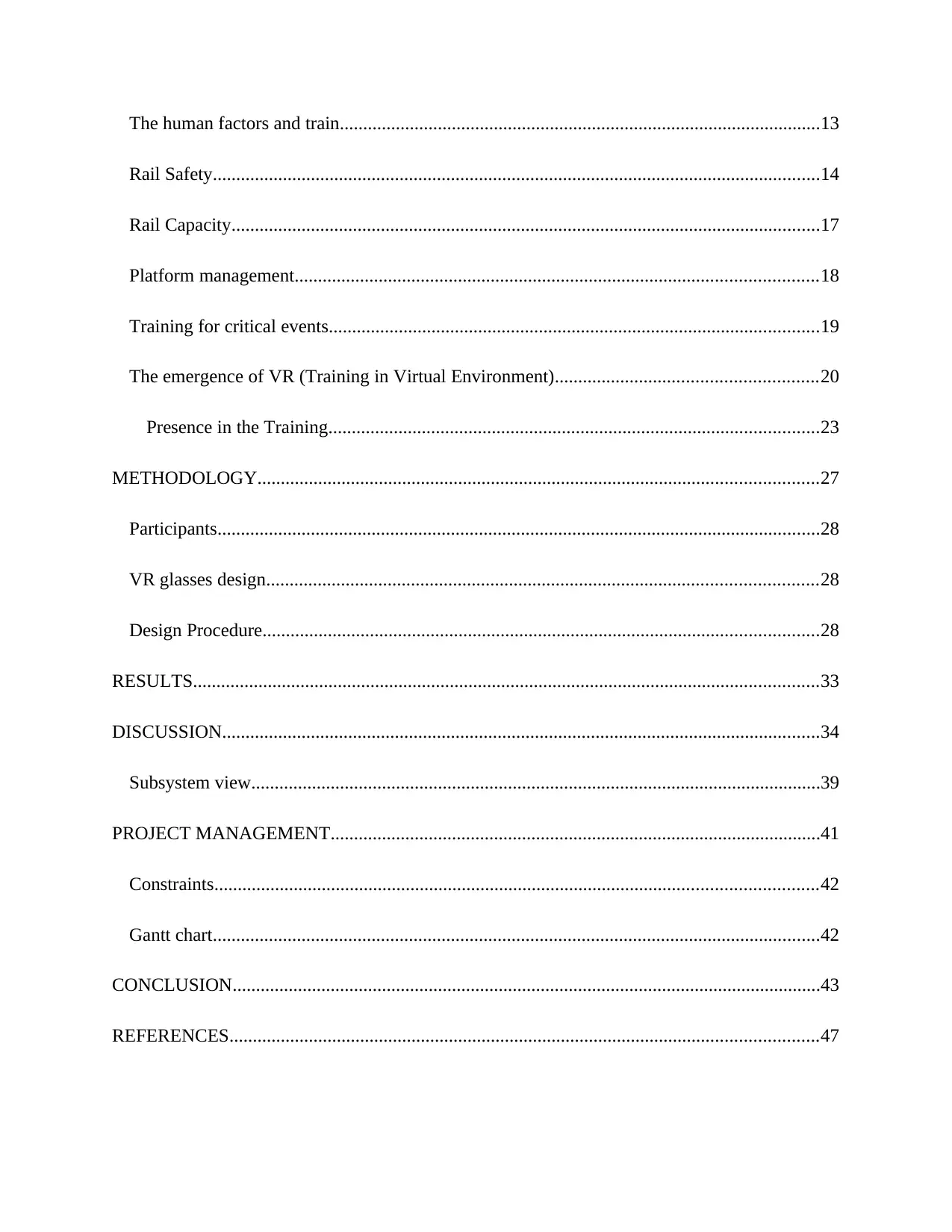
The human factors and train.......................................................................................................13
Rail Safety..................................................................................................................................14
Rail Capacity..............................................................................................................................17
Platform management................................................................................................................18
Training for critical events.........................................................................................................19
The emergence of VR (Training in Virtual Environment)........................................................20
Presence in the Training.........................................................................................................23
METHODOLOGY........................................................................................................................27
Participants.................................................................................................................................28
VR glasses design......................................................................................................................28
Design Procedure.......................................................................................................................28
RESULTS......................................................................................................................................33
DISCUSSION................................................................................................................................34
Subsystem view..........................................................................................................................39
PROJECT MANAGEMENT.........................................................................................................41
Constraints.................................................................................................................................42
Gantt chart..................................................................................................................................42
CONCLUSION..............................................................................................................................43
REFERENCES..............................................................................................................................47
Rail Safety..................................................................................................................................14
Rail Capacity..............................................................................................................................17
Platform management................................................................................................................18
Training for critical events.........................................................................................................19
The emergence of VR (Training in Virtual Environment)........................................................20
Presence in the Training.........................................................................................................23
METHODOLOGY........................................................................................................................27
Participants.................................................................................................................................28
VR glasses design......................................................................................................................28
Design Procedure.......................................................................................................................28
RESULTS......................................................................................................................................33
DISCUSSION................................................................................................................................34
Subsystem view..........................................................................................................................39
PROJECT MANAGEMENT.........................................................................................................41
Constraints.................................................................................................................................42
Gantt chart..................................................................................................................................42
CONCLUSION..............................................................................................................................43
REFERENCES..............................................................................................................................47
Paraphrase This Document
Need a fresh take? Get an instant paraphrase of this document with our AI Paraphraser
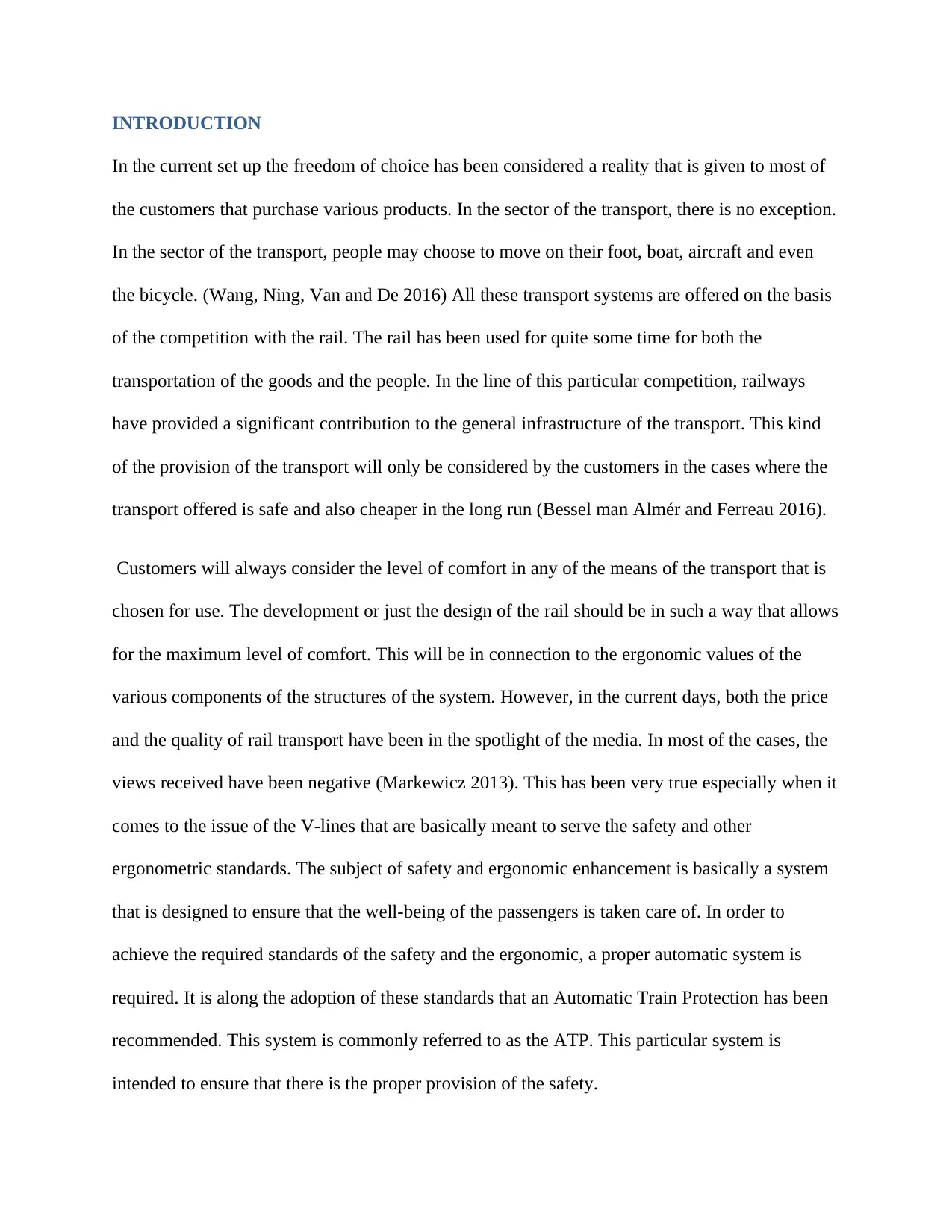
INTRODUCTION
In the current set up the freedom of choice has been considered a reality that is given to most of
the customers that purchase various products. In the sector of the transport, there is no exception.
In the sector of the transport, people may choose to move on their foot, boat, aircraft and even
the bicycle. (Wang, Ning, Van and De 2016) All these transport systems are offered on the basis
of the competition with the rail. The rail has been used for quite some time for both the
transportation of the goods and the people. In the line of this particular competition, railways
have provided a significant contribution to the general infrastructure of the transport. This kind
of the provision of the transport will only be considered by the customers in the cases where the
transport offered is safe and also cheaper in the long run (Bessel man Almér and Ferreau 2016).
Customers will always consider the level of comfort in any of the means of the transport that is
chosen for use. The development or just the design of the rail should be in such a way that allows
for the maximum level of comfort. This will be in connection to the ergonomic values of the
various components of the structures of the system. However, in the current days, both the price
and the quality of rail transport have been in the spotlight of the media. In most of the cases, the
views received have been negative (Markewicz 2013). This has been very true especially when it
comes to the issue of the V-lines that are basically meant to serve the safety and other
ergonometric standards. The subject of safety and ergonomic enhancement is basically a system
that is designed to ensure that the well-being of the passengers is taken care of. In order to
achieve the required standards of the safety and the ergonomic, a proper automatic system is
required. It is along the adoption of these standards that an Automatic Train Protection has been
recommended. This system is commonly referred to as the ATP. This particular system is
intended to ensure that there is the proper provision of the safety.
In the current set up the freedom of choice has been considered a reality that is given to most of
the customers that purchase various products. In the sector of the transport, there is no exception.
In the sector of the transport, people may choose to move on their foot, boat, aircraft and even
the bicycle. (Wang, Ning, Van and De 2016) All these transport systems are offered on the basis
of the competition with the rail. The rail has been used for quite some time for both the
transportation of the goods and the people. In the line of this particular competition, railways
have provided a significant contribution to the general infrastructure of the transport. This kind
of the provision of the transport will only be considered by the customers in the cases where the
transport offered is safe and also cheaper in the long run (Bessel man Almér and Ferreau 2016).
Customers will always consider the level of comfort in any of the means of the transport that is
chosen for use. The development or just the design of the rail should be in such a way that allows
for the maximum level of comfort. This will be in connection to the ergonomic values of the
various components of the structures of the system. However, in the current days, both the price
and the quality of rail transport have been in the spotlight of the media. In most of the cases, the
views received have been negative (Markewicz 2013). This has been very true especially when it
comes to the issue of the V-lines that are basically meant to serve the safety and other
ergonometric standards. The subject of safety and ergonomic enhancement is basically a system
that is designed to ensure that the well-being of the passengers is taken care of. In order to
achieve the required standards of the safety and the ergonomic, a proper automatic system is
required. It is along the adoption of these standards that an Automatic Train Protection has been
recommended. This system is commonly referred to as the ATP. This particular system is
intended to ensure that there is the proper provision of the safety.
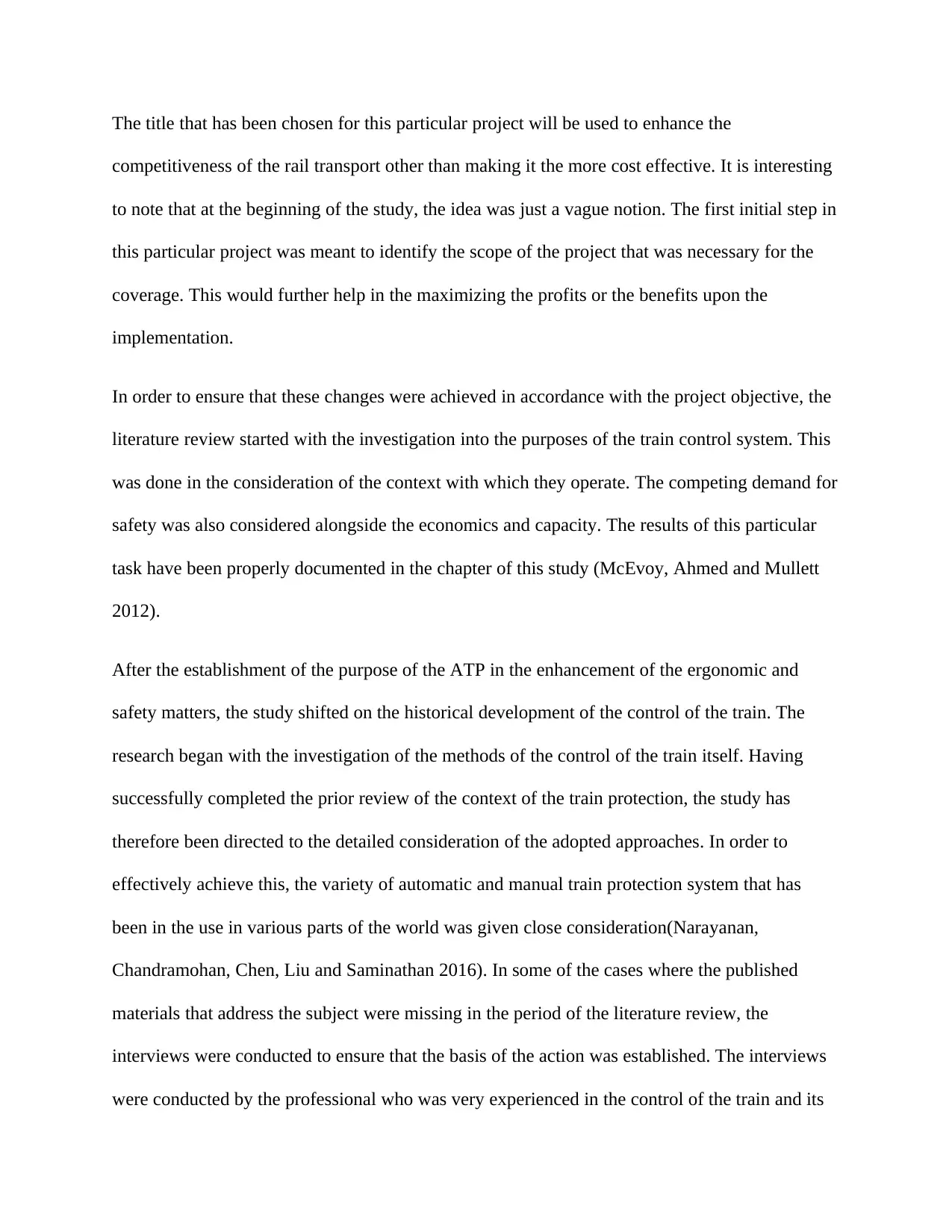
The title that has been chosen for this particular project will be used to enhance the
competitiveness of the rail transport other than making it the more cost effective. It is interesting
to note that at the beginning of the study, the idea was just a vague notion. The first initial step in
this particular project was meant to identify the scope of the project that was necessary for the
coverage. This would further help in the maximizing the profits or the benefits upon the
implementation.
In order to ensure that these changes were achieved in accordance with the project objective, the
literature review started with the investigation into the purposes of the train control system. This
was done in the consideration of the context with which they operate. The competing demand for
safety was also considered alongside the economics and capacity. The results of this particular
task have been properly documented in the chapter of this study (McEvoy, Ahmed and Mullett
2012).
After the establishment of the purpose of the ATP in the enhancement of the ergonomic and
safety matters, the study shifted on the historical development of the control of the train. The
research began with the investigation of the methods of the control of the train itself. Having
successfully completed the prior review of the context of the train protection, the study has
therefore been directed to the detailed consideration of the adopted approaches. In order to
effectively achieve this, the variety of automatic and manual train protection system that has
been in the use in various parts of the world was given close consideration(Narayanan,
Chandramohan, Chen, Liu and Saminathan 2016). In some of the cases where the published
materials that address the subject were missing in the period of the literature review, the
interviews were conducted to ensure that the basis of the action was established. The interviews
were conducted by the professional who was very experienced in the control of the train and its
competitiveness of the rail transport other than making it the more cost effective. It is interesting
to note that at the beginning of the study, the idea was just a vague notion. The first initial step in
this particular project was meant to identify the scope of the project that was necessary for the
coverage. This would further help in the maximizing the profits or the benefits upon the
implementation.
In order to ensure that these changes were achieved in accordance with the project objective, the
literature review started with the investigation into the purposes of the train control system. This
was done in the consideration of the context with which they operate. The competing demand for
safety was also considered alongside the economics and capacity. The results of this particular
task have been properly documented in the chapter of this study (McEvoy, Ahmed and Mullett
2012).
After the establishment of the purpose of the ATP in the enhancement of the ergonomic and
safety matters, the study shifted on the historical development of the control of the train. The
research began with the investigation of the methods of the control of the train itself. Having
successfully completed the prior review of the context of the train protection, the study has
therefore been directed to the detailed consideration of the adopted approaches. In order to
effectively achieve this, the variety of automatic and manual train protection system that has
been in the use in various parts of the world was given close consideration(Narayanan,
Chandramohan, Chen, Liu and Saminathan 2016). In some of the cases where the published
materials that address the subject were missing in the period of the literature review, the
interviews were conducted to ensure that the basis of the action was established. The interviews
were conducted by the professional who was very experienced in the control of the train and its
⊘ This is a preview!⊘
Do you want full access?
Subscribe today to unlock all pages.

Trusted by 1+ million students worldwide
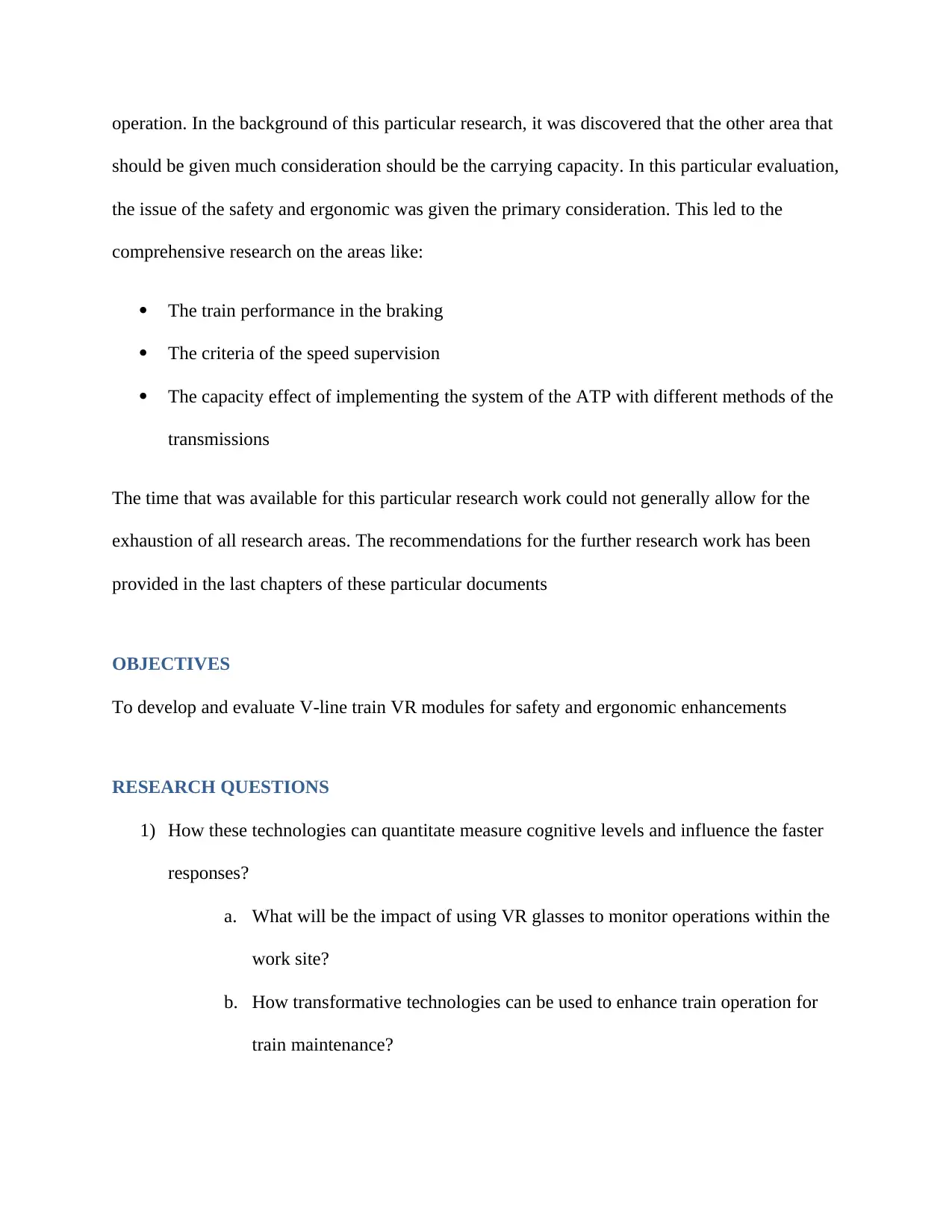
operation. In the background of this particular research, it was discovered that the other area that
should be given much consideration should be the carrying capacity. In this particular evaluation,
the issue of the safety and ergonomic was given the primary consideration. This led to the
comprehensive research on the areas like:
The train performance in the braking
The criteria of the speed supervision
The capacity effect of implementing the system of the ATP with different methods of the
transmissions
The time that was available for this particular research work could not generally allow for the
exhaustion of all research areas. The recommendations for the further research work has been
provided in the last chapters of these particular documents
OBJECTIVES
To develop and evaluate V-line train VR modules for safety and ergonomic enhancements
RESEARCH QUESTIONS
1) How these technologies can quantitate measure cognitive levels and influence the faster
responses?
a. What will be the impact of using VR glasses to monitor operations within the
work site?
b. How transformative technologies can be used to enhance train operation for
train maintenance?
should be given much consideration should be the carrying capacity. In this particular evaluation,
the issue of the safety and ergonomic was given the primary consideration. This led to the
comprehensive research on the areas like:
The train performance in the braking
The criteria of the speed supervision
The capacity effect of implementing the system of the ATP with different methods of the
transmissions
The time that was available for this particular research work could not generally allow for the
exhaustion of all research areas. The recommendations for the further research work has been
provided in the last chapters of these particular documents
OBJECTIVES
To develop and evaluate V-line train VR modules for safety and ergonomic enhancements
RESEARCH QUESTIONS
1) How these technologies can quantitate measure cognitive levels and influence the faster
responses?
a. What will be the impact of using VR glasses to monitor operations within the
work site?
b. How transformative technologies can be used to enhance train operation for
train maintenance?
Paraphrase This Document
Need a fresh take? Get an instant paraphrase of this document with our AI Paraphraser
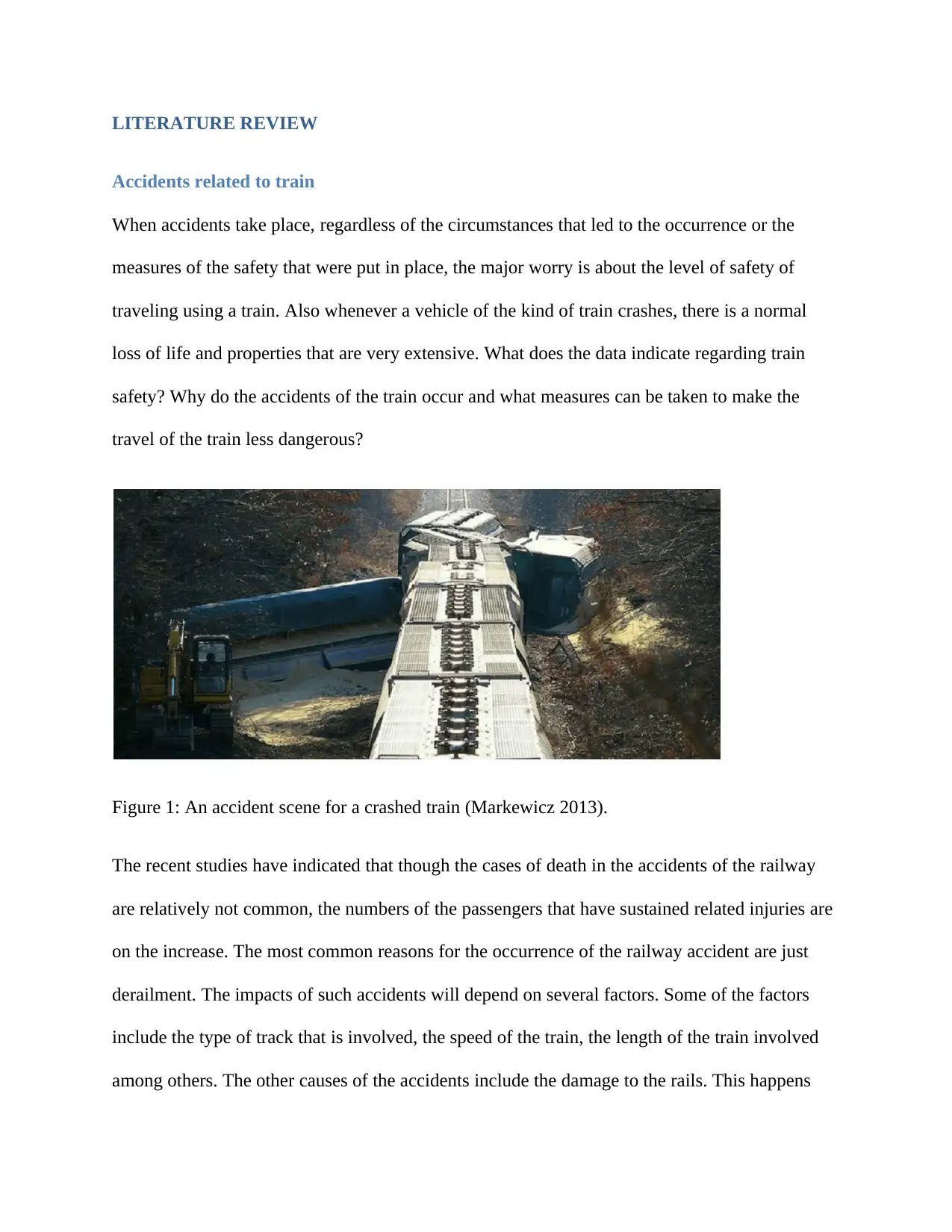
LITERATURE REVIEW
Accidents related to train
When accidents take place, regardless of the circumstances that led to the occurrence or the
measures of the safety that were put in place, the major worry is about the level of safety of
traveling using a train. Also whenever a vehicle of the kind of train crashes, there is a normal
loss of life and properties that are very extensive. What does the data indicate regarding train
safety? Why do the accidents of the train occur and what measures can be taken to make the
travel of the train less dangerous?
Figure 1: An accident scene for a crashed train (Markewicz 2013).
The recent studies have indicated that though the cases of death in the accidents of the railway
are relatively not common, the numbers of the passengers that have sustained related injuries are
on the increase. The most common reasons for the occurrence of the railway accident are just
derailment. The impacts of such accidents will depend on several factors. Some of the factors
include the type of track that is involved, the speed of the train, the length of the train involved
among others. The other causes of the accidents include the damage to the rails. This happens
Accidents related to train
When accidents take place, regardless of the circumstances that led to the occurrence or the
measures of the safety that were put in place, the major worry is about the level of safety of
traveling using a train. Also whenever a vehicle of the kind of train crashes, there is a normal
loss of life and properties that are very extensive. What does the data indicate regarding train
safety? Why do the accidents of the train occur and what measures can be taken to make the
travel of the train less dangerous?
Figure 1: An accident scene for a crashed train (Markewicz 2013).
The recent studies have indicated that though the cases of death in the accidents of the railway
are relatively not common, the numbers of the passengers that have sustained related injuries are
on the increase. The most common reasons for the occurrence of the railway accident are just
derailment. The impacts of such accidents will depend on several factors. Some of the factors
include the type of track that is involved, the speed of the train, the length of the train involved
among others. The other causes of the accidents include the damage to the rails. This happens
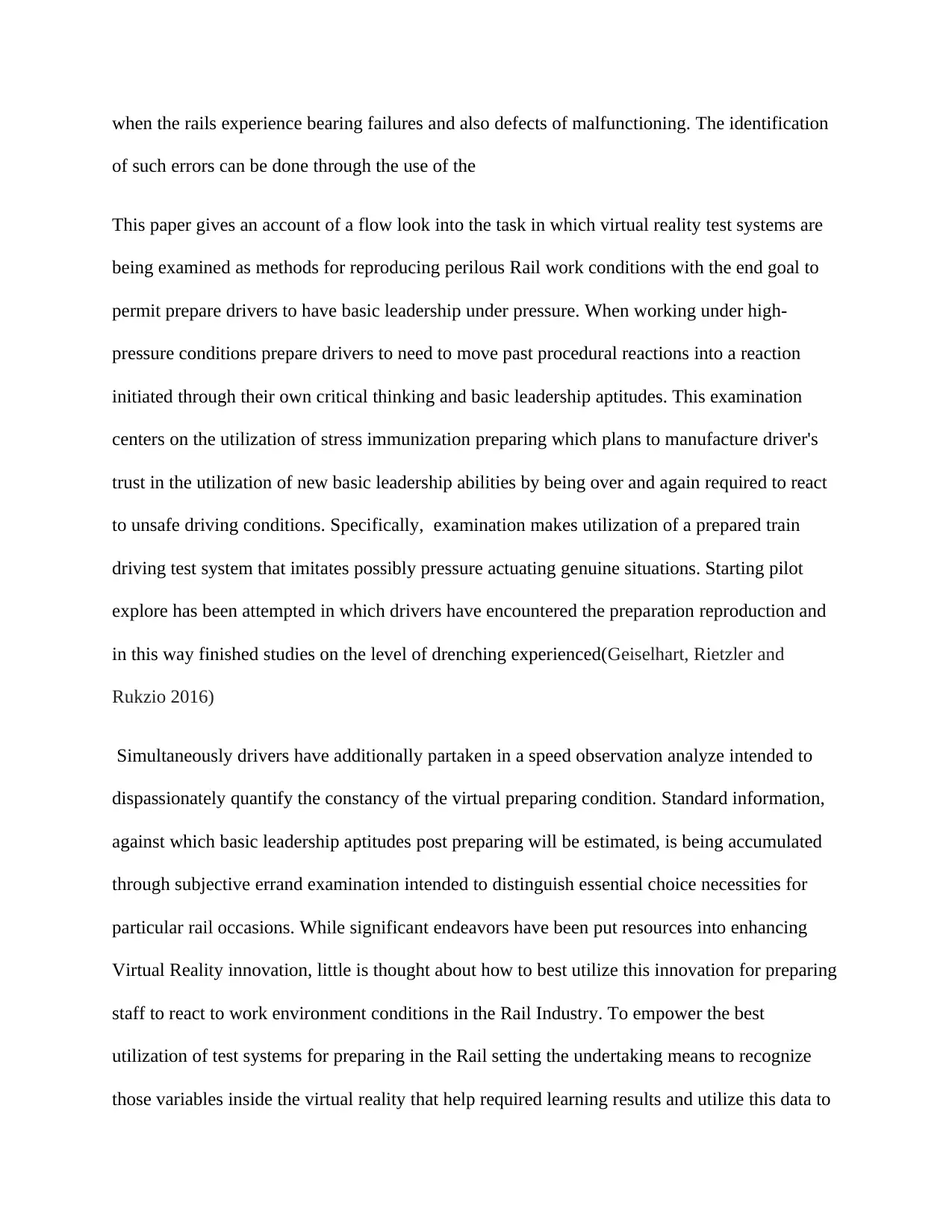
when the rails experience bearing failures and also defects of malfunctioning. The identification
of such errors can be done through the use of the
This paper gives an account of a flow look into the task in which virtual reality test systems are
being examined as methods for reproducing perilous Rail work conditions with the end goal to
permit prepare drivers to have basic leadership under pressure. When working under high-
pressure conditions prepare drivers to need to move past procedural reactions into a reaction
initiated through their own critical thinking and basic leadership aptitudes. This examination
centers on the utilization of stress immunization preparing which plans to manufacture driver's
trust in the utilization of new basic leadership abilities by being over and again required to react
to unsafe driving conditions. Specifically, examination makes utilization of a prepared train
driving test system that imitates possibly pressure actuating genuine situations. Starting pilot
explore has been attempted in which drivers have encountered the preparation reproduction and
in this way finished studies on the level of drenching experienced(Geiselhart, Rietzler and
Rukzio 2016)
Simultaneously drivers have additionally partaken in a speed observation analyze intended to
dispassionately quantify the constancy of the virtual preparing condition. Standard information,
against which basic leadership aptitudes post preparing will be estimated, is being accumulated
through subjective errand examination intended to distinguish essential choice necessities for
particular rail occasions. While significant endeavors have been put resources into enhancing
Virtual Reality innovation, little is thought about how to best utilize this innovation for preparing
staff to react to work environment conditions in the Rail Industry. To empower the best
utilization of test systems for preparing in the Rail setting the undertaking means to recognize
those variables inside the virtual reality that help required learning results and utilize this data to
of such errors can be done through the use of the
This paper gives an account of a flow look into the task in which virtual reality test systems are
being examined as methods for reproducing perilous Rail work conditions with the end goal to
permit prepare drivers to have basic leadership under pressure. When working under high-
pressure conditions prepare drivers to need to move past procedural reactions into a reaction
initiated through their own critical thinking and basic leadership aptitudes. This examination
centers on the utilization of stress immunization preparing which plans to manufacture driver's
trust in the utilization of new basic leadership abilities by being over and again required to react
to unsafe driving conditions. Specifically, examination makes utilization of a prepared train
driving test system that imitates possibly pressure actuating genuine situations. Starting pilot
explore has been attempted in which drivers have encountered the preparation reproduction and
in this way finished studies on the level of drenching experienced(Geiselhart, Rietzler and
Rukzio 2016)
Simultaneously drivers have additionally partaken in a speed observation analyze intended to
dispassionately quantify the constancy of the virtual preparing condition. Standard information,
against which basic leadership aptitudes post preparing will be estimated, is being accumulated
through subjective errand examination intended to distinguish essential choice necessities for
particular rail occasions. While significant endeavors have been put resources into enhancing
Virtual Reality innovation, little is thought about how to best utilize this innovation for preparing
staff to react to work environment conditions in the Rail Industry. To empower the best
utilization of test systems for preparing in the Rail setting the undertaking means to recognize
those variables inside the virtual reality that help required learning results and utilize this data to
⊘ This is a preview!⊘
Do you want full access?
Subscribe today to unlock all pages.

Trusted by 1+ million students worldwide
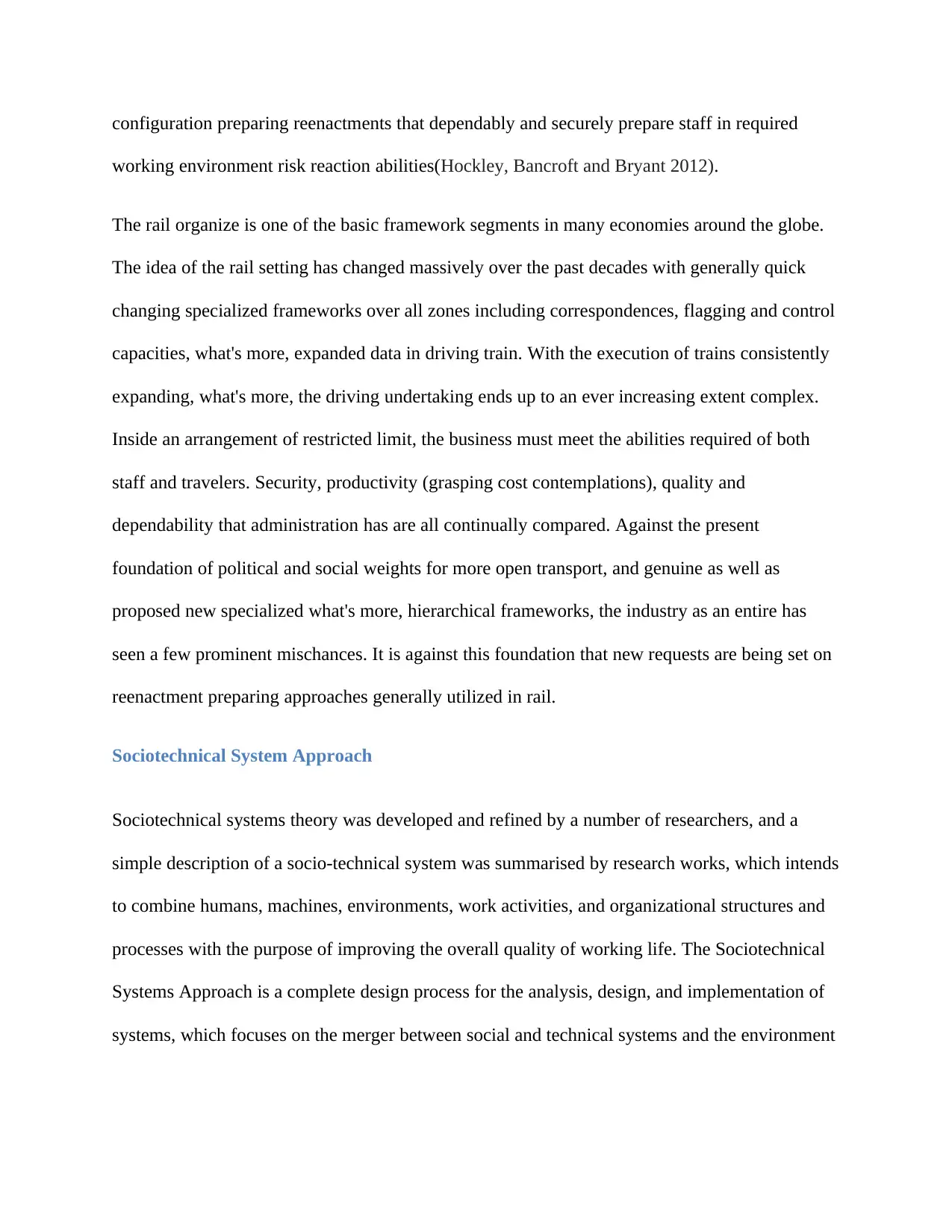
configuration preparing reenactments that dependably and securely prepare staff in required
working environment risk reaction abilities(Hockley, Bancroft and Bryant 2012).
The rail organize is one of the basic framework segments in many economies around the globe.
The idea of the rail setting has changed massively over the past decades with generally quick
changing specialized frameworks over all zones including correspondences, flagging and control
capacities, what's more, expanded data in driving train. With the execution of trains consistently
expanding, what's more, the driving undertaking ends up to an ever increasing extent complex.
Inside an arrangement of restricted limit, the business must meet the abilities required of both
staff and travelers. Security, productivity (grasping cost contemplations), quality and
dependability that administration has are all continually compared. Against the present
foundation of political and social weights for more open transport, and genuine as well as
proposed new specialized what's more, hierarchical frameworks, the industry as an entire has
seen a few prominent mischances. It is against this foundation that new requests are being set on
reenactment preparing approaches generally utilized in rail.
Sociotechnical System Approach
Sociotechnical systems theory was developed and refined by a number of researchers, and a
simple description of a socio-technical system was summarised by research works, which intends
to combine humans, machines, environments, work activities, and organizational structures and
processes with the purpose of improving the overall quality of working life. The Sociotechnical
Systems Approach is a complete design process for the analysis, design, and implementation of
systems, which focuses on the merger between social and technical systems and the environment
working environment risk reaction abilities(Hockley, Bancroft and Bryant 2012).
The rail organize is one of the basic framework segments in many economies around the globe.
The idea of the rail setting has changed massively over the past decades with generally quick
changing specialized frameworks over all zones including correspondences, flagging and control
capacities, what's more, expanded data in driving train. With the execution of trains consistently
expanding, what's more, the driving undertaking ends up to an ever increasing extent complex.
Inside an arrangement of restricted limit, the business must meet the abilities required of both
staff and travelers. Security, productivity (grasping cost contemplations), quality and
dependability that administration has are all continually compared. Against the present
foundation of political and social weights for more open transport, and genuine as well as
proposed new specialized what's more, hierarchical frameworks, the industry as an entire has
seen a few prominent mischances. It is against this foundation that new requests are being set on
reenactment preparing approaches generally utilized in rail.
Sociotechnical System Approach
Sociotechnical systems theory was developed and refined by a number of researchers, and a
simple description of a socio-technical system was summarised by research works, which intends
to combine humans, machines, environments, work activities, and organizational structures and
processes with the purpose of improving the overall quality of working life. The Sociotechnical
Systems Approach is a complete design process for the analysis, design, and implementation of
systems, which focuses on the merger between social and technical systems and the environment
Paraphrase This Document
Need a fresh take? Get an instant paraphrase of this document with our AI Paraphraser
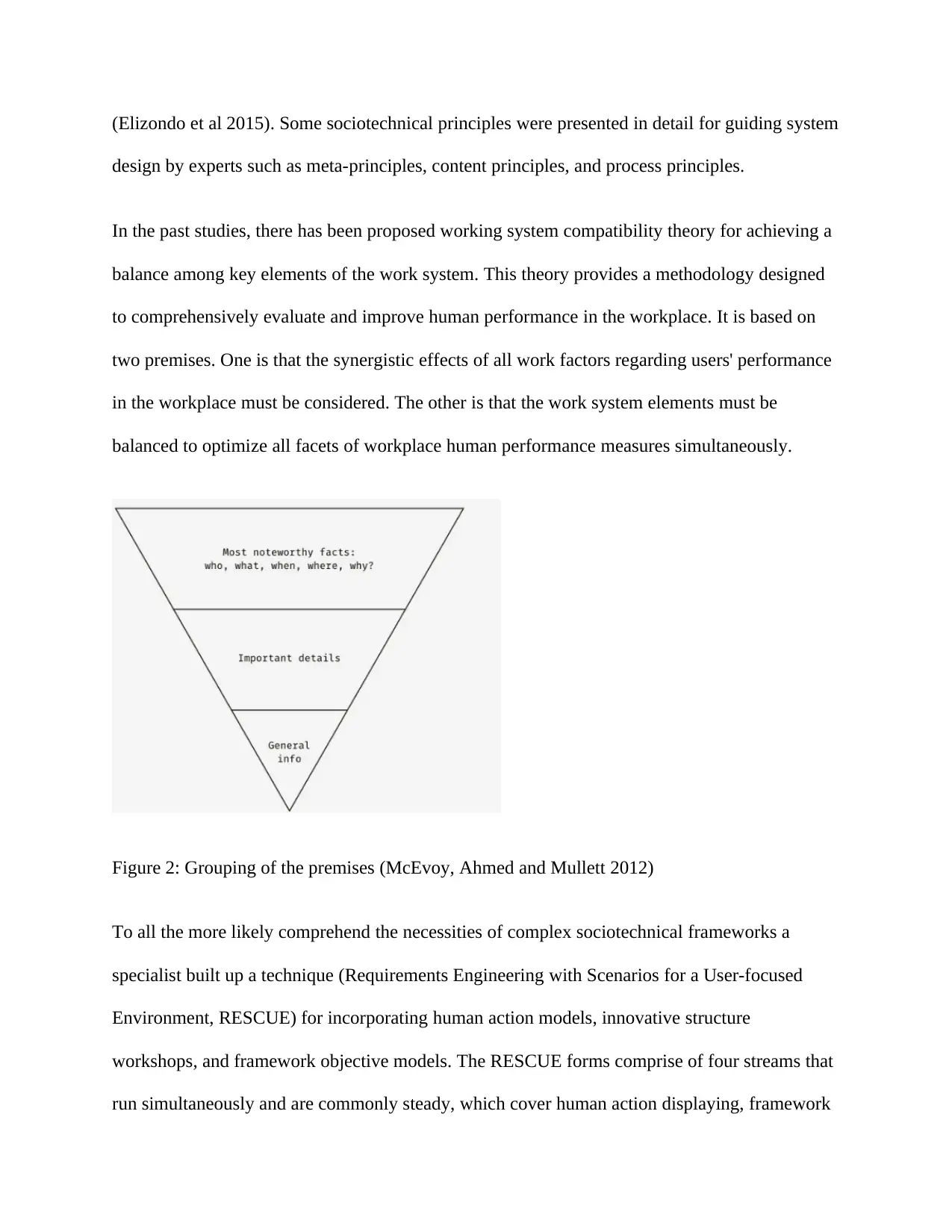
(Elizondo et al 2015). Some sociotechnical principles were presented in detail for guiding system
design by experts such as meta-principles, content principles, and process principles.
In the past studies, there has been proposed working system compatibility theory for achieving a
balance among key elements of the work system. This theory provides a methodology designed
to comprehensively evaluate and improve human performance in the workplace. It is based on
two premises. One is that the synergistic effects of all work factors regarding users' performance
in the workplace must be considered. The other is that the work system elements must be
balanced to optimize all facets of workplace human performance measures simultaneously.
Figure 2: Grouping of the premises (McEvoy, Ahmed and Mullett 2012)
To all the more likely comprehend the necessities of complex sociotechnical frameworks a
specialist built up a technique (Requirements Engineering with Scenarios for a User-focused
Environment, RESCUE) for incorporating human action models, innovative structure
workshops, and framework objective models. The RESCUE forms comprise of four streams that
run simultaneously and are commonly steady, which cover human action displaying, framework
design by experts such as meta-principles, content principles, and process principles.
In the past studies, there has been proposed working system compatibility theory for achieving a
balance among key elements of the work system. This theory provides a methodology designed
to comprehensively evaluate and improve human performance in the workplace. It is based on
two premises. One is that the synergistic effects of all work factors regarding users' performance
in the workplace must be considered. The other is that the work system elements must be
balanced to optimize all facets of workplace human performance measures simultaneously.
Figure 2: Grouping of the premises (McEvoy, Ahmed and Mullett 2012)
To all the more likely comprehend the necessities of complex sociotechnical frameworks a
specialist built up a technique (Requirements Engineering with Scenarios for a User-focused
Environment, RESCUE) for incorporating human action models, innovative structure
workshops, and framework objective models. The RESCUE forms comprise of four streams that
run simultaneously and are commonly steady, which cover human action displaying, framework
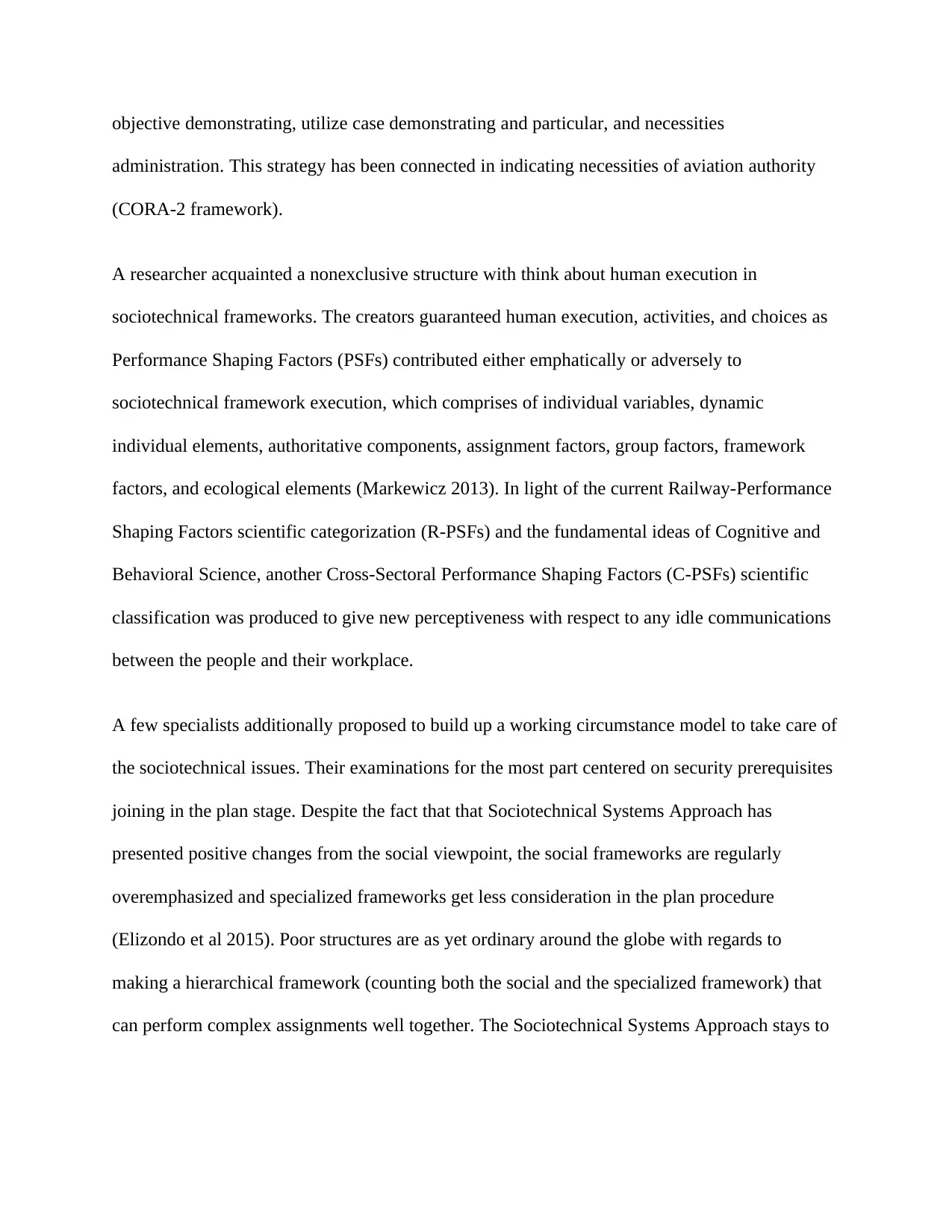
objective demonstrating, utilize case demonstrating and particular, and necessities
administration. This strategy has been connected in indicating necessities of aviation authority
(CORA-2 framework).
A researcher acquainted a nonexclusive structure with think about human execution in
sociotechnical frameworks. The creators guaranteed human execution, activities, and choices as
Performance Shaping Factors (PSFs) contributed either emphatically or adversely to
sociotechnical framework execution, which comprises of individual variables, dynamic
individual elements, authoritative components, assignment factors, group factors, framework
factors, and ecological elements (Markewicz 2013). In light of the current Railway-Performance
Shaping Factors scientific categorization (R-PSFs) and the fundamental ideas of Cognitive and
Behavioral Science, another Cross-Sectoral Performance Shaping Factors (C-PSFs) scientific
classification was produced to give new perceptiveness with respect to any idle communications
between the people and their workplace.
A few specialists additionally proposed to build up a working circumstance model to take care of
the sociotechnical issues. Their examinations for the most part centered on security prerequisites
joining in the plan stage. Despite the fact that that Sociotechnical Systems Approach has
presented positive changes from the social viewpoint, the social frameworks are regularly
overemphasized and specialized frameworks get less consideration in the plan procedure
(Elizondo et al 2015). Poor structures are as yet ordinary around the globe with regards to
making a hierarchical framework (counting both the social and the specialized framework) that
can perform complex assignments well together. The Sociotechnical Systems Approach stays to
administration. This strategy has been connected in indicating necessities of aviation authority
(CORA-2 framework).
A researcher acquainted a nonexclusive structure with think about human execution in
sociotechnical frameworks. The creators guaranteed human execution, activities, and choices as
Performance Shaping Factors (PSFs) contributed either emphatically or adversely to
sociotechnical framework execution, which comprises of individual variables, dynamic
individual elements, authoritative components, assignment factors, group factors, framework
factors, and ecological elements (Markewicz 2013). In light of the current Railway-Performance
Shaping Factors scientific categorization (R-PSFs) and the fundamental ideas of Cognitive and
Behavioral Science, another Cross-Sectoral Performance Shaping Factors (C-PSFs) scientific
classification was produced to give new perceptiveness with respect to any idle communications
between the people and their workplace.
A few specialists additionally proposed to build up a working circumstance model to take care of
the sociotechnical issues. Their examinations for the most part centered on security prerequisites
joining in the plan stage. Despite the fact that that Sociotechnical Systems Approach has
presented positive changes from the social viewpoint, the social frameworks are regularly
overemphasized and specialized frameworks get less consideration in the plan procedure
(Elizondo et al 2015). Poor structures are as yet ordinary around the globe with regards to
making a hierarchical framework (counting both the social and the specialized framework) that
can perform complex assignments well together. The Sociotechnical Systems Approach stays to
⊘ This is a preview!⊘
Do you want full access?
Subscribe today to unlock all pages.

Trusted by 1+ million students worldwide
1 out of 60
Your All-in-One AI-Powered Toolkit for Academic Success.
+13062052269
info@desklib.com
Available 24*7 on WhatsApp / Email
![[object Object]](/_next/static/media/star-bottom.7253800d.svg)
Unlock your academic potential
Copyright © 2020–2025 A2Z Services. All Rights Reserved. Developed and managed by ZUCOL.
